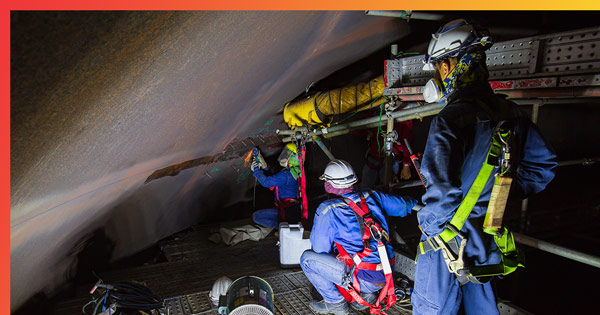On one of my many winter survival trips, I deliberately put myself into a confined space situation. I built a shelter that day that was completely enclosed, with the exception of a four-foot by two-foot-wide door. I was able to squeeze my entire body inside (which is no small feat at 6’ 7” tall!) but had little room to move around and work once inside. My intention was to keep the heat inside my shelter to protect me from the frigid winter temperatures outside.
Around 8 pm, I started the fire outside my shelter. I built it in just a way so it would deflect the heat back into my shelter. It was a great plan, until around two in the morning when suddenly, the front side of my shelter caught fire. I immediately sprung into action and was able to get out of my tiny doorway for a quick escape. Thankfully, I was able to wiggle my way out, but not without burning some parts of my clothes, half of my right pant leg was gone and some of the shelter collapsed on my legs. Luckily, I received no physical injuries. The fire started so fast I hardly had time to react to the situation. Because of my confined space training, I was able to escape quickly and without injury. Had I not been trained on confined space and known the hazards surrounding confined spaces, my outcome may have been tragically different.

What is the difference between confined space and permit-required confined space? That’s the million-dollar question. In our industry, there is often confusion between the two, and not knowing, could prove hazardous. The code and regulations referencing confined space can be found in 29 CFR 1910.146. Reading and understanding these codes could prove crucial in our industry. It’s important to have training with confined spaces in your facility as well. Not only is it required by OSHA and strictly enforced, but training could also prevent injury or even death.
Many hazards can occur in a confined space. Sixty-one percent of confined space deaths result from the physical hazards of entering a confined area. Physical hazards include heat, impact, falls and engulfment. Thirty-nine percent lose their lives due to atmospheric hazards such as oxygen deficiency, toxic chemicals and combustible dust.
There are four steps you can take to ensure proper identification of confined space versus permit-required confined space. The first one is a site evaluation cataloging what you have onsite. The second step is identification of proper safety equipment and the required tools to help you succeed in the event of an emergency. The third step is to have a trained rescue team that has developed a pre-plan program before you enter the confined area. The final step is to have certified training that involves practice and hands-on experience for all parties who will work in or around that area.
A confined space is:
- Large enough for an employee to enter fully and to perform assigned work
- Not designed for continuous occupancy by the employee
- Limited or restricted in means of entry and exit
A permit-required confined space:
- Contains or has the potential to contain a hazardous atmosphere
- Contains a material with a potential to engulf someone who enters the space
- Has an internal configuration that might cause an entrant into that area to be trapped or asphyxiated by inwardly converging walls or by a floor that slopes downward and tapers to a smaller cross section
- Contains any other recognized serious safety or health hazards
In addition to knowing which type of confined space you have on-site, it is essential you are well-informed regarding your Personal Protective Equipment or PPE. At one of my training facilities, I was told about a man who was entering a manhole cover on his job site. Before he opened the manhole, he chose not to wear the correct PPE and did not use the confined space monitor to make certain the atmosphere showed favorable to enter. When he opened the manhole cover, two percent oxygen rushed out and immediately knocked him unconscious. He fell thirty feet down into the manhole. All it takes is that one time that can change your entire life and that of your family.
Make certain you know each item of your PPE’s uses and limitations: The Air Purifying Respirator (APR) is not designed to be used in any IDLH (Immediately Dangerous to Life and Health) situation such as any PPM (Parts per Million) at or above three hundred (two hundred and fifty in some states) as well as anything under 19.5% oxygen. The cartridges on your APR are chemical specific as well as the monitor. Make sure you know what the meter is telling you and how to understand it.
The confined space meter will tell you the level of oxygen and will alert you if there are any levels of excess chemicals in the area.
There should always be two people present when working in any confined space area. This is essential in the event of a confined space emergency because the additional person can either leave to get help or start a rescue operation for the person who is in danger. Additionally, this will ensure proper documentation of the emergency following the event.
Confined space accidents can happen in the blink of an eye. One wrong decision or simply being complacent are the conduits for people getting injured on the job site. In my line of work, I frequently hear people say, “I don’t wear the PPE because I have done this job for ten years and nothing has happened yet.” This is the worst attitude to have on the job site and the very definition of complacency. Utilize the training materials and PPE at your facility to help you succeed at your job. Know what you are reading and how to apply that knowledge to practical scenarios. The goal for all of us is to get home safely to our loved ones who depend on us and look forward to us coming home each day.
About Us

Industrial Consultants, LLC is celebrating its third decade of service providing the training needs for companies like yours. Companies that must comply with health and safety regulations enacted by the Occupational Safety and Health Administration and the Environmental Protection Agency.
Recent Posts

Emergency Response Plan


